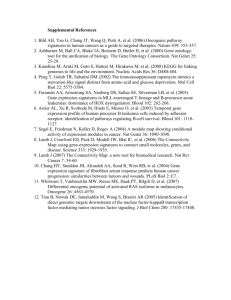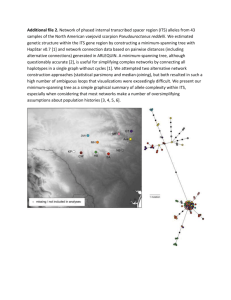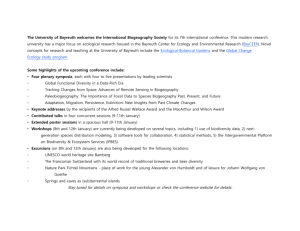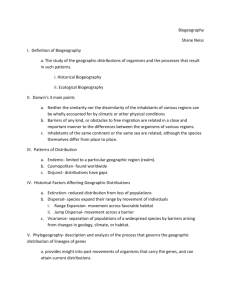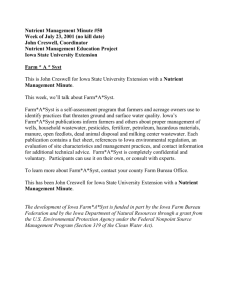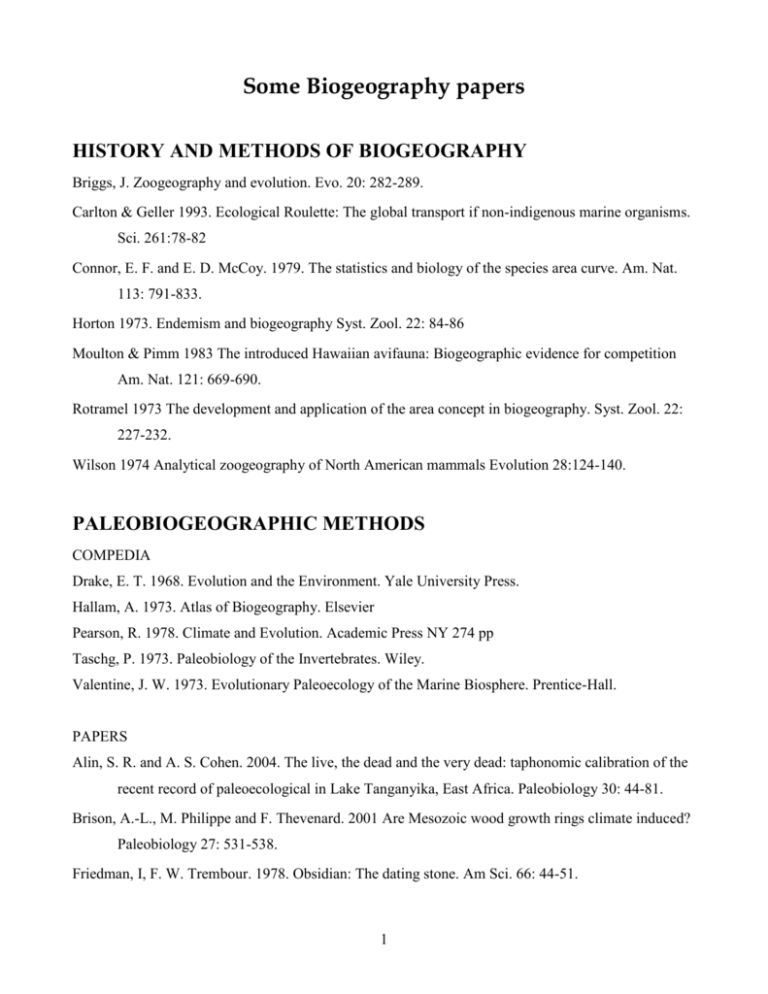
Some Biogeography papers
HISTORY AND METHODS OF BIOGEOGRAPHY
Briggs, J. Zoogeography and evolution. Evo. 20: 282-289.
Carlton & Geller 1993. Ecological Roulette: The global transport if non-indigenous marine organisms.
Sci. 261:78-82
Connor, E. F. and E. D. McCoy. 1979. The statistics and biology of the species area curve. Am. Nat.
113: 791-833.
Horton 1973. Endemism and biogeography Syst. Zool. 22: 84-86
Moulton & Pimm 1983 The introduced Hawaiian avifauna: Biogeographic evidence for competition
Am. Nat. 121: 669-690.
Rotramel 1973 The development and application of the area concept in biogeography. Syst. Zool. 22:
227-232.
Wilson 1974 Analytical zoogeography of North American mammals Evolution 28:124-140.
PALEOBIOGEOGRAPHIC METHODS
COMPEDIA
Drake, E. T. 1968. Evolution and the Environment. Yale University Press.
Hallam, A. 1973. Atlas of Biogeography. Elsevier
Pearson, R. 1978. Climate and Evolution. Academic Press NY 274 pp
Taschg, P. 1973. Paleobiology of the Invertebrates. Wiley.
Valentine, J. W. 1973. Evolutionary Paleoecology of the Marine Biosphere. Prentice-Hall.
PAPERS
Alin, S. R. and A. S. Cohen. 2004. The live, the dead and the very dead: taphonomic calibration of the
recent record of paleoecological in Lake Tanganyika, East Africa. Paleobiology 30: 44-81.
Brison, A.-L., M. Philippe and F. Thevenard. 2001 Are Mesozoic wood growth rings climate induced?
Paleobiology 27: 531-538.
Friedman, I, F. W. Trembour. 1978. Obsidian: The dating stone. Am Sci. 66: 44-51.
1
Gregory-Wodzicki, K. M. 2000. Relationships between leaf morphology and climate, Bolivia:
implications for estimating paleoclimate from fossil floras. Paleobiology 26: 668-688.
van de Schootbrugge, B., T. R. Bailey, Y. Rosenthal, M. E. Katz, J. D. Wright, K. G. Miller S. FeistBurkhardt and P. G. Falkowski. 2005. Early Jurassic climate change and the radiation of
organic-walled phytoplankton in the Tethys Ocean. Paliobiology 31: 73-97.
Williams, C. J., A. H. Johnson, B. A. LePage, D. R. Vann and K. D Taylor. 2003. Reconstruction of
Tertiary Metasequoia forests I. Test of a method for biomass determination based on stem
dimensions. Paleobiology 29: 256-270.
2
MOLECULAR APPROACHES
Dick, C. W., K. Abdul-Salim and E. Bermingham. 2003. Molecular systematic analysis reveals cryptic
tertiary diversification of a wide spread tropical rainforest tree. Am. Nat. 162: 691-703.
Downie et al. 2001 Grapes galls and geography: the distribution of nuclear and mitochondrial DNA
variation across host-plant species and regions in a specialist herbivore Evolution 55: 13361344.
Elderkin et al 2001. Shifts in allele frequency in zebra mussels, Dreissena polymorpha along the
latitudinal gradient formed by the Mississippi River. JNABS 20:595.
Hormiga, G., M. Arendo and R. C. Gillespie. 2003. Speciation on a conveyor belt: Sequential
colonization of the Hawaiian Islands by Orsonwelles spiders (Araneae, Linyphiidae) Syst. Biol.
52: 70-87.
Jordan, S. C. Simon, D. Polhemus 2003. Molecular systematics and adaptive radiation of Hawaii’s
endemic damselfly genus Megalagrion (Odonata: Coenagrionidae) Syst. Biol 52: 89-109.
Renner et al. 2001 Melastomae come full circle: Biogeographic reconstruction and molecular clock
dating. Evolution 55: 1299-1307
Simmons 2001 Geographic variation in female preference functions and male songs of the field cricket
Teleogryllus oceanicus. Evolution 55: 1386-1394.
Migration/ Disperal
Higgins, S. I., R. Nathan and M. L. Cain. 2003. Are long-distance dispersal events in plants usually
caused by nonstandard means of dispersal? Ecol. 84: 1945-1956.
Kinlan, B. P. and S. D. Gains. 2003. Propagule dispersal in marine and terrestrial environments: a
community perspective. Ecol. 84: 2007-2020.
Kinnison et al 2001 Migratory costs and the evolution of egg size and number in introduced and
indigenous salmon populations Evolution 55: 1656-1667.
Levin, S. a., H. C. Muller-Landau, R. Nathan, and J. Chave. The ecology and evolution of seed
dispersal: A theoretical Prespective. Ann. Rev. Ecol. Syst. 34. 575-604.
Levine, J. M., and D. J. Murrell. 2003. The community-level consequences of seed dispersal patterns.
2003. Ann Rev. Ecol. Syst. 34: 549-574.
3
Nepokroeff, M. K. S. Sytsma, W. L. Wagner and E. A. Zimmer. 2003. Reconstructing ancestral
patterns of colonization and dispersal in the Hawaiian understory tree genus Psychotria
(Rubiaceae)L A comparison of parsimony and likelihood approaches. Syst. Biol. 52: 820-838.
Rouget, M., and D. M. Richardson. 2003. Inferring process from pattern in plant invasions: A
semimechanistic model incorporating propagule pressure and environmental factors. Am. Nat.
162: 713-724.
Waters, J. M., and M. S. Roy. 2004. Out of Africa: The slow train to Australia. Syst. Biol. 53: 18 – 24.
FRESHWATER
Arnegard, M. E., S. M. Bogdanowicz and C. D. Hopkins. 2005. Multiple cases of striking genetic
similarity between alternate electric fish signal morphs in sympatry. Evolution. 59: 324-343.
Banarescu, Problems of Zoogeography of freshwater animals IN Principles and Problems of
Zoogeography
Bilton, D. T., Joanna R. Freeland, & Beth Okamura. 2001. Dispersal in freshwater invertebrates. Ann.
Rev. Ecol. Syst. 32: 159-182.
Gerber et al. 2001. The role of introgresive hybridization of the Gila robusta complex (Teleostei:
Cyprinidae) Evolution. 55: 2028-2039.
Johnson, D. S. 1960. Some aspects of the distribution of freshwater organisms in the Indo-Pacific area
and their relevance to the validity of the concept of an oriental region in zoogeography. Cent.
and Bicent. Congr. Biol. Singapore
Myers, G. S. 1953. Paleogeographical significance of freshwater fish distribution in the Pacific. Proc.
7th Pac. Sci Congr. 38-48.
Orti, G. and A. Meyer. 1997. The radiation of characiform fishes, and the limits of resolution of
mitochondrial ribosomal DNA sequences. Syst. Biol. 46: 75 – 100.
Waters et al. 2001. Genes meet geology: Fish phylogeographic pattern reflects ancient rather than
modern drainage connections Evolution 55 1844-1851.
MARINE
Armsworth et al. 2001. When to press on or turn back: Dispersal strategies for reef fish larvae. Am.
Nat 157: 434-450.
4
Bernardi, G. 2005. Phylogeography and demography of sympatric sister surfperch species, Embiotoca
jacksoni and E. latralis along the California coast: Historical vs. ecological factors. Evolution
59: 386 – 394.
Brown et al. 2001. Gene flow vs local adaptation in the northern acorn barnacle Semibalanus
balanoides: Insights from mitochondrial DNA variation Evolution 55: 1972-1979.
Connolly, S. R., D. R. Bellwood, and T. P. Hughes. 2003 Indo-Pacific biodiversity of coral refs:
deviations from a mid-domain model. Ecol. 84. 2178-2190.
Crame, J. A. 2002. Evolution of taxonomic diversity gradients in the marine realm: a comparison of
Late Jurassic and Recent bivalve faunas. Paleobiology 28: 184-207.
Dana, T. F. 1975. Development of contemporary Eastern Pacific coral reefs. Mar. Biol. 33: 355-374.
Emerson, W. K. 1978. Mollusks with Indo-Pacific faunal affinities in the eastern Pacific Ocean.
Nautilus 92:91-96
Jackson, J. B. C. 1974 Biogeographic consequences of eurytopy & stenotopy among marine bivalves
and their evolutionary significance. Am. Nat. 108: 541-560.
Levin, L. A. et al. 2001. Environmental influences on regional deep-sea species diversity. Ann. Rev.
Ecol. Syst. 32: 51-94.
Levinton, J. 1970. Opportunistic species are not generally resource limited. Lethaia 3: 69-78.
McCoy, E. D. and K. L. Heck 1976. Biogeography of corals, seagrasses and mangroves: an alternative
to the center of origin concept. Am. Nat. 25: 201-210.
Stehli, F. C. and J. W. Wells 1971. Diversity and age: patterns in hermatypic corals. Syst. Zool.
20:115-126
Stepien et al. Phylogeography of the spotted sand bass Paralabrax maculatofasciatus : Divergence of
Gulf of California and Pacific Coast populations Evolution 55: 1852-1862.
Taylor, M. S. and M. E. Hellberg. 2005. Marine radiations at small spatial scales: Speciation in
Neotropical reef gobies (Elacatinus). Evolution 59: 374 – 385.
Vermeij, G. J. 1972. Endemism and environment: Some shore mollusks of the tropical Atlantic. Am.
Nat. 106:89-101.
TERRESTRIAL PHYTOGEOGRAPHY
Comes et al. 2001 Molecular phylogeography, reticulation and lineage sorting in Mediterranean Senica
Sect. Senico (Asteraceae) Evolution 55: 1943-1962.
5
Johnson et al. 1968. Ecological parameters and plant species diversity Am. Nat 102: 297-306.
Linder, H. P. 2001. On areas of endemism, with an example from the African Restionaceae. Syst. Biol.
50: 892-912.
Williams, C. J., A. H. Johnson, B. A. LePage, D. R. Vann and T. Sweda. 2003. Reconstruction of
Tertiary Metasequoia forests II. Structure, biomass, and productivity of Eocene floodplain
forests in the Canadian Arctic. Paleobiology 29: 271-292.
Wing, S. L. & G. J. Harrington 2001. Floral response for rapid warming in the earliest Eocene and
implications for concurrent faunal change. Paleobiology 27. 539-563.
TERRESTRIAL ZOOGEOGRAPHY
Ashton et al. 2000. Is Bergman’s lid for mammals? Am Nat. 156: 390-415.
Bardwell et al. 2001. Adaptive geographic variation in Western scrub Jays Ecology 82: 2617-2627.
Evans, B. J., R. M. Brown, J. A. McGuire, J. Supriatna, N. Andayani, A. Diesmis, D. Iskandar, D. J.
Melnick and D. A. Cannatella. 2003. Phylogenetics of fanged frogs: testing biogeographical
hypotheses at the interface of the Asian and Australian Faunal zones. Syst. Biol. 52: 794-819.
Fleischer, 2001 Phylogeography of the Asian elephant (Elephas maximus) based on mitochondrial
DNA Evolution 55: 1882-1892.
Porter et al. 2001Latitudinal gradients in colony size for Social Insects: Termites and ants show
different patterns. Am. Nat. 157 97-
ISLANDS
Abbott, I. And P. R. Grant 1976. Non-equilibrial bird faunas on Islands Am. Nat. 110: 507-528.
Brock, R. E. C. Lewis and R. C. Wass 1979. Stability and structure of a fish community on a coral
patch reef. Mar Biol. 1979. 54:281-292.
Brotons, L., M Mönkkönen and J. L. Martin. 2003. Are fragments islands? Landscape context and
density-area relationships in boreal forest birds. Am. Nat. 162: 343-357.
Brown, D. no date. Stephens Island. Cloudybay Publishing
Brown, J. 1971. Boreal mammals of the Great Basin. Am. Nat. 105:467-478.
6
Cornell H. V & J. O. Washburn 1979. Evolution of the richness-area correlation for cyprinid gall
wasps on oak trees: A comparison of two geographic areas. Evolution 33: 257-274.
Culver, D. C. 1976.The evolution of aquatic cave communities Am. Nat. 110:945-957
Diamond, J. 1974. Colonization of exploded volcanic islands by birds: The supertramp strategy. Sci.
184:803-806.
Diamond, J. 1979. Comparison of faunal equilibrium turnover rates on a tropical and a temperate
island. Proc. Nat. Acad. Sci. 68:249
Diamond, J. and J. Karr. 1972. Density compensation in island faunas. Ecol. 53: 330-342.
Dillon Jr., R. T. and A. R. Wethington 1995. The biogeography of sea islands; Clues from the
population genetics of the freshwater snail Physa heterostropha. Syst. Biol. 44: 400-408.
Edpath, S. M. 1995. Habitat fragmentation and the individual: Tawny owls Strix aluco in woodland
patches. J. Anim. Ecol. 64: 652-661.
Goldstein, E. L. Island biogeography of ants. Evolution 29:750-762.
Hamilton, T. H. and I. Rubinoff 1967. On predicting insular variation in endemism and sympatry for
the Darwin’s finches in the Galapagos archipelago. Am. Nat. 101: 161
Hutching, G. The Natrual World of New Zealand. Viking.1994
Lister, B. C. 1976. The nature of niche expansion in West Indian Anolis lizards II Evolutionary
components Evolution 30: 677-692.
Lister, B. C. 1976. The nature of niche expansion in West Indian Anolis lizards I Ecological
consequences of reduced competition. Evolution 30: 659-676.
Little, T. J. and P. D. N. Hebert. 1996. Endemism and ecological islands: The ostracods from Jamaican
bromeliads. Freshwater Biol. 36: 327-338.
Morse, D. H. 1971. The foraging of warblers isolated on small islands. Ecol. 52: 216-228.
Morse, D. H. 1977. The occupation of small islands by Passerine birds. Condor 79:399-412.
Schoener, A. 1974 Experimental zoogeography: Colonization of marine mini-islands Am. Nat.
108:715-738.
Shoener, T. W. J. Clobert, S. Legendre and D. A. Spiller. 2003. Life-history models of extinction: A
test with island spiders. Am Nat. 162: 558-573.
Simberloff, D. 1969. Experimental zoogeography of Islands: A model for insular colonization
Ecology. 50: 296
7
Simberloff, D. 1976. Trophic structure determination and equilibrium in an arthropod community
Ecology 57:396-398.
Simberloff, D. and E. O., Wilson 1969. Experimental zoogeography of islands: The colonization of
empty islands. Ecol. 50:278-296.
Taylor, R. J. and P. J. Regal 1978. The peninsular effect on species diversity and the biogeography of
Baja California. Am. Nat. 112: 583-593.
Terborgh, J., L. Lopez and J. Tello. 1997. Bird communities in transition; The Lago Guri Islands. Ecol.
78: 1494-1501.
Vuimmeumier, F. 1970. Insular biogeography in continental regions. I. The northern Andes of South
America. Am. Nat. 104:373-388.
Yeaton, R. I. 1974. An ecological analysis of chaparral and pine forest bird communities on Santa Cruz
Is. And mainland California. Ecol. 55: 959-973.
PATTERNS
Bremer, K. 1992. Ancestral areas: A cladistic reinterpretation of the center of origin concept. Syst.
Biol. 41: 436-445.
Briggs, J. C. 2003. Fishes and birds: Gondwana life rafts revisited. Syst. Biol. 52: 548-553.
Crist, T. O., J. A. Veech, J. C. Gering and K. S. Summerville. 2003. Partitioning species diversity
across landscapes and regions: A hierarchical analysis of α, β, and γ diversity. Am. Nat6. 162:
734-743.
Hawkins, B. A. E. C. Porter and J. A. Felizola Diniz-Filho. 2003. Productivity and history as predictors
of the latitudinal diversity gradient of terrestrial birds. Ecol. 84: 1608-1623.
Janzen H. 1970 Herbivores and the number of tree species in tropical forests. Am. Nat. 104: 501-528.
Linder, H. P., P. Eldanäs, and B. G. Briggs. 2003. Contrasting patterns of radiation in African and
Australian Restionaceae. Evol. 57: 2688-2702.
Vuilleimer, F. 1972. Bird species diversity in Patagonia. Am. Nat. 106: 266-271.
Wilig, M. R., D. M. Kaufman and R. D. Stevens. 2003. latitudinal gradients of biodiversity: pattern,
process, Scale, and synthesis. Ann. Rev. Ecol. Syst. 34: 273-310.
8
EARTH SCIENCE
Cloud, P. 1980 Beyond plate tectonics Am. Sci. 68: 381-387.
Bambach, R. K. et al. 1980. Before Pangea: The geographies of the paleozoic world. Am. Sci. 68: 2638.
O’Hare, G., J. Sweeny and R. Wilby. 2005. Weather, Climate and Climate Change. Pearson/Prentice
Hall, Harlow 403pp
ECOLOGICAL FACTORS
Harrison, S. 1997. How natural habitat patchyness affects the distribution of diversity in California
serpentine chaparral Ecol. 78:1898-1906.
PALEOCLIMATES
Beaty, C. B. 1978. The causes of glaciation. Am. Sci. 66: 452-459
Brison, Anne-Lise, M. Philippe & F. Thevenard. 2001. Are Mesozoic wood growth patterns climate
induced? Paleobiology. 27: 531-538.
Siegert, M. J., J. A. Dowdswell, J-I Svendsen and Anders Everhøi. 2002. The Eurasian arctic during
the last ice age. Am Sci. 90: 32-39.
PALEOBIOGEOGRAPHY
Bambach, R. 1993. Seafood through time. Paleobiology 19:372-397
Bambach, R. K. 1977. Species richness in marine benthic habitats through the Phanerozoic.
Paleobiology 3: 152-167.
Bambach, R. K. A. H. Knoll and S. C. Wang. 2004. Originations, extinctions and mass depletions of
marine diversity. Paleobiology. 30: 522-542.
Beck, M. W. 1996. On discerning the cause of late Pleistocene megafaunal extinctions Paleobiology
22: 91-103.
Cracraft, J. 1974. Continental drift and vertebrate distribution. Ann. Rev. Ecol. Syst. 5: 215-261.
9
Edinger, E. N. J. M. Pandolfi & R. A. Kelley. Community structure of Quaternary coral reefs
compared with recent life and death assemblages. Paliobiology. 27: 669-694.
Gilinsky, N. L. and I. J. Good 1991. Probabilities of origination and extinction of families of
invertebrate life. Paleobiology 17: 145-166.
Kershaw, P. and B. Wagstaff. 2001. The southern conifer family Arucariaceae: History, status and
value for paleoenvironmental reconstructions. Ann. Rev. Ecol. Syst. 32: 397-414.
Lane, A. and M. J. Benton 2003. Taxonomic level as a determinant of the shape of the Phanerozoic
marine biodiversity curve.
Lieberman, B. L. 2003. Paleobiogeography: The relevance of fossils to biogeography. Ann. Rev. Ecol.
Syst. 34. 51-70.
Miller, A. I. 2000. Conversations about phanerozoic global diversity in Deep Time
Peters, S. 2004. Relative abundance of Sepkowski's evolutionary faunas in Cambrian-Ordovician deep
Subtidal environments in North America. Paleobiology 30: 543-560.
Quinn, J. F. 1983. Mass extinctions in the fossil record. Science 219:1239-1240.
Raup. D. M. 1991. A kill curve for Phanerozoic marine species. Paleobiology. 17: 37 – 48.
Raup, D. M. and J. J. Sepkowski. 1982. Mass extinctions in the marine fossil record. Science
215:1501-1503.
Sepkowski, J. J, 1988. Alpha, Beta and Gamma diversity: where does all the diversity go?
Paleobiology 14:221-234.
Sepkowski, J. J. 1976. Species diversity in the Phanerozoic: Species area effects. Paleobiology 2: 298303.
Sepkowski, J. J. 1978. A kinetic model of Phanerozoic taxonomic diversity. I Analysis of marine
orders. Paleobiology 4:223-251.
Sepkowski, J. J. 1991. A model of onshore-offshore change in faunal diversity. Paleobiology 17: 5877.
Sepkowski, J. J., R. K. Bambach, D. M. Raup and J. W. Valentine. 1981. Phanerozoic marine
diversity: a strong signal from the fossil record. Nature 293: 435-437.
Signor P. W. 1978. Species richness in the Phanerozoic: An investigation of sampling effects.
Paleobiology 4: 394-406.
10
Trewick, S. A. & G. P. Wallis. 2001 Bridging the “Beech-gap”: New Zealand invertebrate
phylogeography implicates pleistocene glaciation and pliocene isolation. Evolution. 55: 21702180.
Valentine, J. W. A. G. Collins and C. P. Meyer. 1994. Morphological complexity increase in
metazoans. Paleobiology 20: 131-142
Wang, S. C. 2003. On the continuity of background and mass extinction. Paleobiology 29: 455-467.
Webb, S. D. 1976. Mammalian faunal dynamics of the great American interchange. Paleobiology 2:
220-234.
Westrop, S. R. 1991. Intercontinental variation in mass extinction patterns: influence of biogeographic
structure. Paleobiology 17: 363-368.
VICARIANCE:
Crisci, J. V., M. M. Cigliano, J. J. Morrone and S. Roig-Juñent. 1991. Historical biogeography of
southern South America. Syst. Zool. 40: 152-171.
Crisp, M. D., H. P. Linder and P. H. Weston. 1995. Cladistic biogeography of plants in Australia and
New Guinea: Congruent pattern reveals two endemic tropical tracks. Syst. Biol. 44: 457-473.
Croizat, L. G. Nelson and D. Rosen 1974. Centers of origin and related concepts Syst Zool. 23: 265287.
Nelson, G. 1973. Comments on Leon Croizat’s biogeography Syst. Zool. 22: 312-320.
Nelson, G. 1974. Historical biogeography: An alternative formalization Syst. Zool. 23:555
Nelson, G and N. Platnick 1981. Systematics and Biogeography Cladistics and Vicariance. Columbia
University Press.
Nelson, G. and D. E. Rosen 1981. Vicariance Biogeography A critique. Columbia Univ. Press.
Rignos, C. 2005. Cryptic vicariance in Gulf of California fishes parallels vicariant patterns found in
Baja California mammals and reptiles. Evo. 59: 2678-2690
Rosen, D. E. 1976. A vicariance model of Caribbean biogeography. Syst Zool. 24: 431-464.
Sanmartín, I., and F. Ronquist. 2004. Southern hemisphere biogeography inferred by event-based
models: Plant vs. animal patterns. Syst. Biol. 53: 216-243
11
HUMAN FACTORS AND INVASIONS:
Sakai, Ann. K. et al. 2001. The population biology of invasive species. Ann. Rev. Ecol. Syst. 32. 305332.
12

